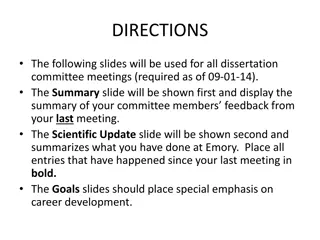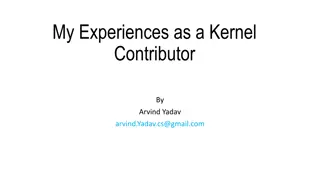
Cost-Effectiveness of Digital Health Interventions in Cardiovascular Disease Management
Explore the cost-effectiveness of digital health interventions in managing cardiovascular conditions, analyzing research gaps, evidence synthesis, and methodologies used. Learn about the potential impacts on healthcare and the importance of Health Technology Assessments in decision-making.
Download Presentation

Please find below an Image/Link to download the presentation.
The content on the website is provided AS IS for your information and personal use only. It may not be sold, licensed, or shared on other websites without obtaining consent from the author. If you encounter any issues during the download, it is possible that the publisher has removed the file from their server.
You are allowed to download the files provided on this website for personal or commercial use, subject to the condition that they are used lawfully. All files are the property of their respective owners.
The content on the website is provided AS IS for your information and personal use only. It may not be sold, licensed, or shared on other websites without obtaining consent from the author.
E N D
Presentation Transcript
COST-EFFECTIVENESS OF DIGITAL HEALTH INTERVENTIONS IN CARDIOVASCULAR DISEASE MANAGEMENT: A NARRATIVE REVIEW Presented By : Prateeksha Yadav Guided By : Dr. Pijush Kanti Khan
1 MENTOR S APPROVAL
2 OVERVIEW Conclusion Introduction Methodology Objectives Result
3 INTRODUCTION Digital Health Interventions transform healthcare through enhanced patient care, access, and cost reduction. In CVDs telemonitoring reduces all-cause mortality and HF-related events in heart failure patients. Internet-based expert system (CardioFit) improves physical activity in coronary heart disease patients. CVD: CardioVascular Disease, HF: Heart Failure
4 Meta-analysis supports the reduction in event rates and improved risk factors. Cost-Effectiveness requires further examination. HTAs needed for informed decision-making on clinical and economic impacts. HTA : Health Technology Assessment
5 OBJECTIVES Objective 1 Objective 2 Objective 3 To identify research gaps and areas for future investigation in the cost-effectiveness of DHIs management. To synthesize evidence on the cost- effectiveness of DHIs in managing various cardiovascular conditions. identify and To analyze the types of DHIs evaluated, the targeted cardiovascular diseases, and the main findings cost-effectiveness outcomes. existing regarding for CVD
6 METHODOLOGY Search Strategy Search electronic databases: PubMed, Web of Science, Cochrane, and Google Scholar. Use keywords related to digital health interventions, cardiovascular diseases, evaluation. Limit search to studies from January 2011 onwards. Perform manual searches of reference lists in relevant articles and systematic reviews. and health economic
7 Study Selection The search results were exported to Rayyan and checked for the duplicates. After removing duplicates, titles and abstracts were screened for eligibility. Full texts of potentially eligible articles were then reviewed for verification.
8 Inclusion & Exclusion Criteria Full-text journal articles in English were included if they meet the following criteria: Target Population: Patients with cardiovascular diseases. Intervention: Digital health promoting or delivering cardiovascular conditions. Comparison: Comparison with conventional care. Outcome: Full-scale health economic evaluation conducted as a cost-effectiveness analysis, cost-utility analysis, cost- benefit analysis, or cost-consequence analysis. interventions clinical aimed at for interventions
9 Data Extraction Data Analysis & Presentation A data extraction form was used to collect relevant information from the included studies. Data items were included general study information, characteristics, details, and summary of findings. Primary outcomes of interest were the cost-effectiveness of DHIs. A descriptive synthesis summarized the types of cardiovascular diseases, modeling methods, perspectives, horizons, and effectiveness outcomes. A flowchart showed the study Additionally the methodological quality and outcomes were summarized. DHIs, targeted time cost- study main methodology selection. cost-effectiveness
10 RESULT Figure 1: PRISMA Flowchart of the study selection process
Incremental cost effectiveness ratio 11 Reference & Year Targeted disease Time Period Type of Study Model typeIntervention vs Is DHI cost effective? Country Perspective comparator Andrija et al., & 2018 Netherlands Heart failure 20 years Health sector Not declared Markov Model Telemonitoring (HTM) and nurse telephone support (NTS) vs usual care HTM and HTM plus Diagnostic Algorithm vs usual care Telerehabilitatio n vs usual care yes 12,479/QALY for HTM 8,270/QALY for NTS Fernando et al., & 2022 Netherlands Heart Failure lifetime Societal Prospective observational study Simulation model yes 27,712/QALY for HTM+DA 34,449/QALY for HTM 21,707/QALY Ines et al., & 2016 Belgium Heart Failure, CAD 6 months Patient RCT Multiple Regression Model Not declared Telerehabilitatio n vs usual care yes Ines et al., & 2017 Belgium CAD & Heart Failure 6 months Health sector RCT yes 3,993/QALY Jordana et al. 2016 USA Heart failure 5 years Patient RCT Markov Model remote monitoring vs CBM $44832/QALY yes Jos et al., & 2017 Netherlands CAD 3 months Societal RCT Not declared Telemonitoring vs centre-based Cost savings insignificant no CR Padraig et al., & 2016 UK CVD risk 12 month Health sector Cohort simulation model Telehealth intervention yes 11,776/QALY RCT QALY: Quality-Adjusted Life Years, CAD : Coronary Artery Disease; RCT: Randomised Control Trial; CBM: Centre -based monitoring CR: Cardiac Rehabilitation
Incremental cost effectiveness ratio 1366.30/QALY 12 Reference & Year Targeted disease Time Period Type of Study Model typeIntervention vs Is DHI cost effective? Country Perspective comparator Paolo et al., & 2013 Europe Heart failure 16 months Health sector RCT Regression model Telemonitoring vs usual care Yes Praveen et al. 2013 UK Heart failure 6 months Health sector Cohort Study Markov Model remote monitoring vs usual care Remote CR vs Centre-Based CR yes 11 873/QALY Ralph et al., & 2018 Australia CAD 3 months Health sector RCT Markov Model no Qaly change | ICER not calculated no Rutger et al., & 2021 Netherlands CAD 2 years Health sector RCT Regression model Telerehabilitation vs centre-based CR $22 840/QALY yes Sheena et al., & 2016 USA Heart failure 1 year Patient Prospective cohort study Markov Model Telehealth intervention $33,337/QALY yes Tianyi et al., & 2023 China AF 6 months Health sector RCT Not declaredDTx based CR vs Home-Based CR 33,572.42 CNY/QALY yes Vinayak et al., & 2021 USA Acute MI 1 year Health sector Prospective observational study Markov Model Corrie DHI $12,530/QALY yes Corrie DHI: smartphone application, smartwatch and wireless blood pressure monitor to support medication tracking, education, vital signs monitoring and care coordination; CHD: Coronary Heart Disease, AF: Atrial Fibrillation, MI: Myocardial Infarction,
13 General Characteristics Study (n=14), n (%) General Characteristics Study (n=14), n (%) Type of Economic Evaluation Region 1. ICER 12 (85.71) 1. Europe 9 (64.28) 2. Cost Savings 2 (14.29) 2. Asia 1 (7.15) Year of Publications 3. Australia 1 (7.15) 1. Before 2016 2 (14.29) 4. North America 3 (21.42) 2. Between 2016-2020 8 (57.14) Model Type 3. After 2020 4 (28.57) 1. Regression Model 3 (21.42) Study Type 2. Markov Model 6 (42.87) 1. RCT 9 (64.28) 3. Simulation Model 2 (14.29) 2. Observational Study 4 (28.57) 4. Not Declared 3 (21.42) 3. Not declared 1 (7.15)
14 CONCLUSION The overall evidence supports the cost-effectiveness of telehealth interventions across various cardiovascular conditions and settings. These interventions often yield cost savings and improved health outcomes, particularly when evaluated over extended periods and broader societal perspectives. However, the cost-effectiveness can be influenced by factors such as the type of intervention, targeted disease, study perspective, and local healthcare cost structures. Future research should continue to refine these models and consider the integration of emerging technologies to optimize the cost-effectiveness of telehealth solutions.






















